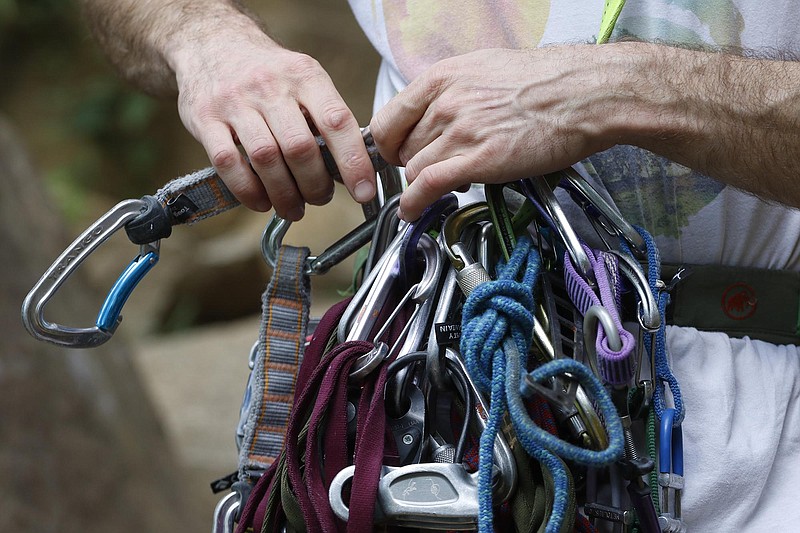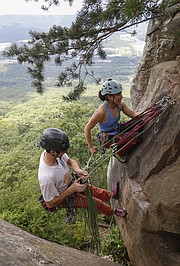TOP CLIMBING SPOTS
› Foster Falls: Difficult, bolted sport climbs. Top rope must be rigged by lead.› Rocktown: Beginner to advanced bouldering. A crash pad and spotter highly recommended. Many formations can be easily set with a top rope.› Sunset Rock: Traditional “TRAD” climbing with some set top rope anchors. Do not anchor to trees. No sport climbing anchors.› Tennessee Wall: Traditional “TRAD” climbing with a very few sport climbing routes. No rope access.› The Stone Fort/Little Rock: Beginner to advanced bouldering. A crash pad and spotter highly recommended.› Walnut Wall: Top rope climbing, beginner to advanced.› Zahnd Natural Area: Bouldering› Highpoint Point Climbing and FitnessSource: Outdoorchattanooga.com
Henry Robinson used to drive from Clemson University in South Carolina several weekends a year to rock climb in the Chattanooga area, sometimes camping out of a car near his climbing destination.
As a newly released study from the University of Tennessee at Chattanooga's Tourism Center points out, climbers are a young, frugal demographic.
But after a day on the rocks, Robinson and friends would frequently make the short drive to downtown Chattanooga to eat at local restaurants and shop at stores like Rock/Creek before returning to their isolated digs for the night.
"Typically, a trip would be to get up here on Friday, maybe make dinner, climb Saturday and then Saturday evening, go into town and get lots of food for recovery and lots of drink," said Robinson, who is now a Chattanooga resident, largely because of its climbing opportunities.
Climbers may not stay at downtown hotels or push baby strollers to traditional tourist venues like the Tennessee Aquarium and Rock City, but thousands of them come to the city from out of town each year and, as the UTC study shows, they're a boon for the local economy.
The study found that - estimating conservatively - climbers brought an impact of $7 million to Hamilton County last year. It asserted that, with a bit more emphasis on the sport, its impact could climb even higher.
"This study is something we have known, obviously, since we've been in the climbing world for a long time," Southeastern Climbers Coalition Executive Director Cody Roney said. "But climbers are a quiet group of people and it's hard to show that impact without the numbers being on paper.
"So this report is a great thing for the community to show to public officials and others that we are bringing a lot of money to the community and that supporting this activity would be very beneficial for the city, county and local businesses."
The study, which focused only on the Tennessee Wall, Sunset Rock and Stone Fort, found those climbing locales brought at least 16,565 non-resident visits during the 2015-16 climbing season. The visiting climbers spent an average of $178 per trip, including $55.35 on food, according to the study.
Fewer than 10 percent of visiting climbers went to Rock City or the Tennessee Aquarium during their stays, but 28.8 percent visited downtown stores and restaurants, 28.2 percent went to another outdoor recreation destination, and 19.5 percent visited High Point Climbing Gym.
"It's a pretty special thing that we have here," Roney said. "People from all over the world come to Chattanooga specifically to climb. A big reason they come here and stay here for so long - you'll see people stay for months at a time - is because we have things to do."
The study, written by an undergraduate researcher and two assistant professors who research the impacts of recreation and sport, suggested the continued development of local climbing areas would bring a more diverse clientele to the region.
It also deduced that investment in climbing management, marketing and infrastructure would "greatly enhance tourism attraction," suggested marketing partnerships with local shops and restaurants and the exploration of creative revenue sources to make a sustainable climbing infrastructure.
"Really, what we're trying to show is that these activities do have an impact," report author Drew Bailey said. "And there's zero financial support from anyone for it."
The Southeastern Climbers Coalition and the Access Fund, a national climbing advocacy organization, each have one full-time staff member based in the area who work to maintain climber resources, access and infrastructure, but the report highlights that they are Chattanooga's only full-time outdoor climbing advocates.
Those groups have partnered with the local Lyndhurst Foundation on a three-year climbing stewardship initiative launching next year that will help with overhauls on crag infrastructure and trails.
But Bailey and representatives from the climbers coalition and the Access Fund agreed that improving relationships among the climbing community and local government, the Chattanooga Convention and Visitors Bureau, park managers and others could strengthen the area's climbing offerings.
"The Chattanooga area is renowned for its diverse crags and boulders, which cater to myriad climbers seeking distinctive sites and experiences," the report reads. "In accordance with this strategic advantage, it is recommended that Chattanooga and its stakeholders remain committed to developing new climbing areas while enhancing existing ones.
"By bolstering Hamilton County's climbing portfolio, Chattanooga may bring a broader demographic of climber-visitors."
While the report highlights private grants as a great revenue source, it suggests that local, state and federal agencies consider adding climbing or recreational support to their budgets because of the tax revenues generated by the activity.
The report estimates that climbing in Chattanooga generates $484,117 annually in state and local taxes.
"We're a piece of that overall tourism pie in that larger slice of outdoor tourism," said Zachary Lesch-Huie, Southeast regional director of the Access Fund. "We're just one piece of that, alongside mountain bikers, paddlers, hunters, anglers, all of them.
"But it's an important piece that is sometimes not recognized, and I think the study is helpful to draw attention to the fact that climbers have a real economic impact."
Contact staff writer David Cobb at dcobb@timesfreepress.com or 423-757-6249.

